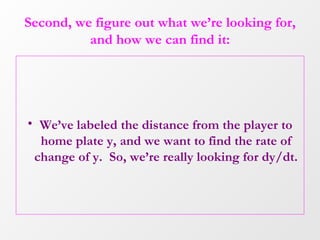Nora
- 1. A softball diamond is a square whose sides are 60 ft. long. A player is running from first to second base at a speed of 25 ft/s at the instant when she is 10 ft from second base. At what rate is the player’s distance from home plate changing at that instant ? #19 on pg. 224 Nora Graubard
- 2. First, we draw and label a picture using the given information: 2 3 1 60 ft Homeplate player x y
- 3. Second, we figure out what we’re looking for, and how we can find it: We’ve labeled the distance from the player to home plate y, and we want to find the rate of change of y. So, we’re really looking for dy/dt.
- 4. Third, we find a formula: We’ll use the pythagorean theorem x ² + 60² = y² If we take the derivative, we’ll have dy/dt in the problem 2x(dx/dt) + 0 = 2y(dy/dt) Unfortunately, there are now two variables. So…
- 5. Third, we plug in values for the instant in question: Using our original Pythagorean Theorem, we find a value for y when the player is 10 ft from second base (or 50 away from first) 50 ² + 60² = y² 10(61 (1/2) ) = y We plug values into the derivative of the original 2x(dx/dt) = 2y (dy/dt) 2(50)(25) = 2[10(61 (1/2) )] (dy/dt)
- 6. Fourth, we multiply out to solve the problem! 125 (61 (1/2) ) = dy/dt




![Third, we plug in values for the instant in question: Using our original Pythagorean Theorem, we find a value for y when the player is 10 ft from second base (or 50 away from first) 50 ² + 60² = y² 10(61 (1/2) ) = y We plug values into the derivative of the original 2x(dx/dt) = 2y (dy/dt) 2(50)(25) = 2[10(61 (1/2) )] (dy/dt)](https://image.slidesharecdn.com/nora-1196286568945369-5/85/Nora-5-320.jpg)
